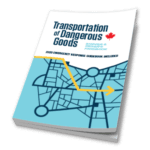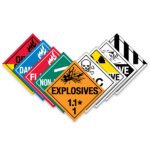Transport Canada Introduces Miscellaneous Amendment to TDG
Usually, the summer is a quiet time for regulatory change. Even regulators get holidays, and July and August are times when offices are at low staff. Most changes get finalized before the heat starts, or after Labor Day. But this July, Transport Canada managed to push through one last amendment to the Transportation of Dangerous Goods Regulations (TDGR) before the summer doldrums.
What Is This Amendment Going to Do?
Now to be honest, this amendment, called the Miscellaneous Program Amendment, isn’t a major shakeup. Instead, as the name implies, it’s a series of minor changes meant to correct textual mistakes, revise legal terminology or clarify information. According to Transport Canada, the objectives are to:
- “repeal obsolete regulatory provisions that have no current application;
- correct discrepancies between the French and English versions;
- harmonize terms used in the TDGR with those used in the Act or related regulations;
- clarify existing provisions;
- correct typographical, grammatical, spelling, numbering, and punctuation errors; and
- update references to standards and other documents incorporated by reference.”
An unusual feature of this amendment is that it was published directly to Canada Gazette Part II, which means it’s in force from the day of publication (July 5, 2023). Apparently because of the limited effect of these changes, Transport Canada opted not to publish a preliminary draft for public comment in Canada Gazette Part I. While this is unusual, it does mean that those of us involved in regulatory compliance don’t have to spend the summer reviewing the proposal and making comments.
Let’s Break Down the Details
So, what changes can we see in this amendment? While nothing is likely to require significant revisions to your transport procedures, the updates in terminology and minor details should still be reviewed to see how they could affect your operations.
- First, for easier reading, references to the titles of Parts have been eliminated from the text. For example, if the section originally referred to “Part 3 (Documentation),” the section will now just read “Part 3.”
- Also, when referring to duties by Transport Canada administration, the regulations will now simply refer to the “Minister” (that is, the Minister of Transportation) rather than including other entities such as the Director General of the Dangerous Goods Directorate. This ensures harmonization with the requirements of the Transportation of Dangerous Goods Act (TDGA), which only refers to the Minister.
- Certain definitions have been replaced with new terminology, including:
- “Certification safety mark” is replaced by “compliance mark” as already defined in the TDGA.
- “Dangerous goods safety mark” is replaced with “dangerous goods mark” as given in the TDGA.
- “Import” has been removed as the TDGA stopped using the word in 2009.
- “Permit for equivalent level of safety” has been replaced with “Equivalency certificate,” as used in the TDGA.
- “Safety mark” and “standardized means of containment” have been removed from section 1.4 of the TDGR, since they are already defined in the Act.
- A minor change is that the order of job functions in sections setting out responsibilities will now always be “offer for transport, handle or transport dangerous goods,” so some of the amended sections will simply involve rearranging the words in the text.
- Since Part 8, Reporting Requirements, no longer uses the word “accidental” for reportable releases, that word has been removed from applicable sections leaving just the word “release.”
- For better alignment with international regulations and the TDGA, the words “hazard” and “hazardous” have been replaced with “danger” and “dangerous.”
Significant Changes to How the TDGR Should Be Used
There are some changes in this amendment which will have a more important effect on the way the regulations work. These include:
- The “500 kilogram exemption” in section 1.16 has been amended to add the option to use labels on packages if they conform to the Canada Consumer Product Safety Act (CCPSA). This will allow products labelled as hazardous consumer products under the “Consumer Chemicals and Containers Regulations, 2001” (CCCR) to be carried without TDGR safety marks and labels.
- Paragraph 3.5(3)(a) on documenting fumigated containers has been modified to change the shipping name from “FUMIGATED UNIT” or “ENGIN SOUS FUMIGATION” to “FUMIGATED CARGO TRANSPORT UNIT” or “ENGIN DE TRANSPORT SOUS FUMIGATION”. This reflects the terminology used in the current UN Recommendations on the Transport of Dangerous Goods.
- The shipping name associated with UN2264 has been changed from “DIMETHYLCYCLOHEXYLAMINE” to “N,N-DIMETHYLCYCLOHEXYLAMINE” to reflect current international usage.
Cleaning Up the Text
Finally, many cleanups of obsolete sections and information have been made, including:
- Sections 1.1 (Coming into Force) and 1.2 (Repeal) have been removed. They refer to transitional periods based on the introduction of the TDGR in 1985 and are no longer relevant.
- Subsections 1.17(6) and 1.17(7) have been removed. They referred to transitional periods for marking limited quantities that are now past.
- References in subsection 1.3(3) to “pounds per square inch” and “psig” have been removed. These are non-metric measurements no longer used.
- Subsection 3.6.1(1) is reworded to remove the reference to “Beginning on July 15, 2015” as that date is passed.
- A reference to the “Small Fishing Vessel Inspection Regulations” (now repealed) is replaced with the current “Fishing Vessel Safety Regulations.”
- In the “Explosives exemption” found in section 1.31, text referring to measurement by “net explosives quantity” has been removed, since it just replicates text found in the Legend to Schedule 1. That text should provide sufficient clarity without repetition in section 1.31.
- Special Provision 155 has been changed to refer to section 7.1.5 of the UN Recommendations rather than 7.1.6, due to a change at the UN level.
- References to the “Packaging and Transport of Nuclear Substances Regulations” have been replaced with references to the newest version, the “Packaging and Transport of Nuclear Substances Regulations, 2015.”
- A few small typographical errors have been corrected and minor changes to enhance harmonization between French and English text have been made. For example, the French shipping name for UN1082 contained the misspelling “RERIGÉRANT” which has now been replaced with “RÉFRIGÉRANT.”
Conclusions
This amendment doesn’t make a lot of major changes, but it does fix quite a few obsolete requirements, typographical errors and simple mistakes that were irritants for shippers, carriers, and receivers. Making these changes will help keep the TDGR as easy to use as possible. While they might have been incorporated in other more significant amendments, doing so now means that when more important amendments (such as the Training Amendment or the Harmonization Amendment) are issued, they are not combined with multiple unrelated small changes.
Questions?
Do you have questions about Regulations? Our team of experts is just a call away for our customers at 855.734.5469 or send us an email, we’re happy to help. We can advise you how to comply with current and upcoming regulations.
Stay up to date and sign up for our newsletter!
We have all the products, services, and training you need to ensure your staff is properly trained and informed.
 Glass Shipping Kits Glass Shipping Kits |
 Canadian TDG Publications Canadian TDG Publications |
 Worded Placards Worded Placards |
Sources:
Government of Canada, Canada Gazette II, Regulations Amending the Transportation of Dangerous Goods Regulations (Miscellaneous Program): SOR/2023-155
Justice Canada, Transportation of Dangerous Goods Act
Justice Canada, Transportation of Dangerous Goods Regulations
Justice Canada, Canada Consumer Product Safety Act
Justice Canada, Consumer Chemicals and Containers Regulations
UN Recommendations on the Transportation of Dangerous Goods, Rev. 22 (2021)







 ICC USA
ICC USA ICC Canada
ICC Canada